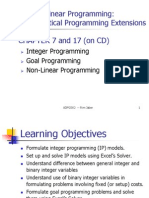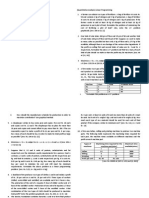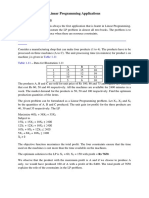Operations Research
Uploaded by
Kushal BothraOperations Research
Uploaded by
Kushal BothraOperations Research
1. ChemLabs uses raw materials I and II to produce two domestic cleaning solutions, A
and B. The daily availabilities of raw materials I and II are 150 and 145 units,
respectively. One unit of solution A consumes 0.5 unit of raw material I and 0.6 unit
of raw material II, and one unit of solution B uses 0.5 unit of raw material I and 0.4
unit of raw material II. The profits per unit of solutions A and B are $8 and $10,
respectively. The daily demand for solution A lies between 30 and 150 units, and that
for solution B between 40 and 200 units. Find the optimal production amounts of A
and B using the Graphical Method.
2. Solve the above problem using the Excel Solver.
3. Determine the optimum solution for each of the following LPs using the Simplex
Method.
a. Maximize z = 2x1 – 4x2 + 5x3 – 6x4
Subject to
x1 + 4x2 -2x3 +8x4 <=2
-x1 +2x2+3x3+4x4 <=1
x1, x2, x3, x4 >= 0
b. Minimize z = x1 + 2x2 – 3x3 – 2x4
Subject to
x1 + x2 <=6
2x1 + x2 <=16
x1, x2 >= 0
4. Suppose that you have 7 full wine bottles, 7 half-full and 7 empty bottles. You would
like to divide the 21 bottles among three individuals so that each will receive exactly
7.Additionally, each individual must receive the same quantity of wine. Express the
problem as Integer Linear Programming and find a solution.(Hint: Use a dummy
objective function in which all the objective coefficients are zero.)
You might also like
- (Quantitative Analysis) Linear ProgrammingNo ratings yet(Quantitative Analysis) Linear Programming2 pages
- UECM2043, UECM2093 Operations Research Tutorial 10% (2)UECM2043, UECM2093 Operations Research Tutorial 15 pages
- Decision Making Using The Analytic Hierarchy Process (AHP) A Step by Step ApproachNo ratings yetDecision Making Using The Analytic Hierarchy Process (AHP) A Step by Step Approach4 pages
- EE 413: Operations Research & Quality Control: Chapter - 1100% (1)EE 413: Operations Research & Quality Control: Chapter - 126 pages
- MSS - CHP 3 - Linear Programming Modeling Computer Solution and Sensitivity Analysis PDFNo ratings yetMSS - CHP 3 - Linear Programming Modeling Computer Solution and Sensitivity Analysis PDF10 pages
- Least Cost Method (LCM), Assignment Help, Transportation Problem in Linear Programming PDF100% (2)Least Cost Method (LCM), Assignment Help, Transportation Problem in Linear Programming PDF2 pages
- Student ID:: Idterm Xamination Cheduling SequencingNo ratings yetStudent ID:: Idterm Xamination Cheduling Sequencing4 pages
- 5 - Getting Started For Simulation ProjectNo ratings yet5 - Getting Started For Simulation Project22 pages
- Integer Programming Formulation ExamplesNo ratings yetInteger Programming Formulation Examples16 pages
- Computer Simulation and Applications in Life Sciences: Dr. Michael Emmerich & Dr. Andre Deutz LiacsNo ratings yetComputer Simulation and Applications in Life Sciences: Dr. Michael Emmerich & Dr. Andre Deutz Liacs37 pages
- OPERTIONS RESEARCH Note From CH I V Revised PDF100% (1)OPERTIONS RESEARCH Note From CH I V Revised PDF145 pages
- Chapter 3, ND Vohra Book Linear Programming II:: Simplex MethodNo ratings yetChapter 3, ND Vohra Book Linear Programming II:: Simplex Method38 pages
- PPT2 - W1-S2 - Simplex Method & Duality Theory-R0No ratings yetPPT2 - W1-S2 - Simplex Method & Duality Theory-R073 pages
- Modeling and Simulation of Logistics Flows 1: Theory and FundamentalsFrom EverandModeling and Simulation of Logistics Flows 1: Theory and FundamentalsNo ratings yet
- Linear Programming: Model Formulation and Graphical SolutionNo ratings yetLinear Programming: Model Formulation and Graphical Solution6 pages
- 1 (I) - Unbounded - Since There Is No Single Poiny in Feasible Region That Can Maximize The FunctionNo ratings yet1 (I) - Unbounded - Since There Is No Single Poiny in Feasible Region That Can Maximize The Function5 pages
- (1c) Linear Programming - Graphical MethodNo ratings yet(1c) Linear Programming - Graphical Method37 pages



























































